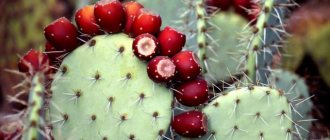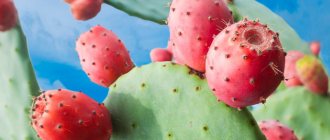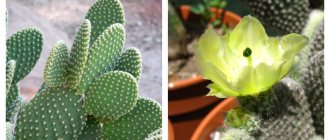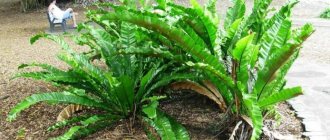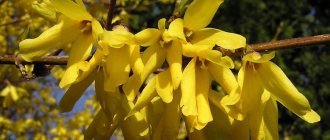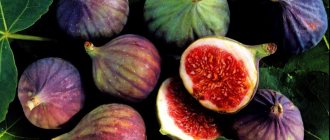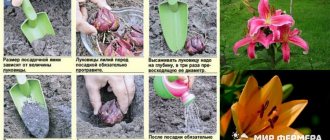Opuntia is the largest genus belonging to the Cactus family. This genus includes approximately 190 species. Under natural conditions, prickly pear can be found in South and North America, not excluding the West Indies. Approximately half of all species are found in Mexico.
There is an Aztec legend that says that the main Aztec city of Tenochtitlan was founded on the very spot where an eagle ate a snake while sitting on a prickly pear. On the coat of arms of Mexico you can see exactly this scene. Some prickly pear species had stems and fruits that were used as food by the Indians. In addition, this cactus was cultivated to obtain a coloring substance such as carmine. However, there are species that are very aggressive neophytes; in order to destroy such prickly pear, biological preparations are used. At home, prickly pear is grown in all countries, even in Australia.
Brief description of cultivation
- Bloom . In indoor culture, prickly pear blooms very rarely.
- Illumination . In the morning, the bush needs a lot of bright light from the sun, but in the afternoon it should be diffused.
- Temperature regime . In the spring-summer period, normal room temperature is suitable for the plant; in winter, the room should not be warmer than 5-7 degrees.
- Watering . In the warm season, the substrate is moistened moderately, and in the winter months, if the bush is at rest, it is not watered at all. Water the bush using the bottom method (through a tray).
- Air humidity . Feels normal in any humidity.
- Fertilizer . The plant is fed once every 30 days in March–September; a mineral complex with a low nitrogen content is suitable for this. From October until the beginning of spring there is no need to feed the cactus.
- Rest period . With the onset of autumn, watering is reduced, the application of fertilizers to the substrate is stopped, and the bush itself is removed to a rather cold place (from 5 to 7 degrees), where it will remain until March.
- Transplant . While the bush is young, it is replanted every year, while older specimens are subjected to this procedure once every 3 or 4 years (not more often). Transplantation is carried out in the spring before the growing season begins.
- Reproduction . In segments, and also rarely use the seed method.
- Pests . Mealybugs, scale insects, spider mites, root-knot nematodes and whiteflies.
- Diseases . Late blight, wet stinking rot, pythium root rot and gray mold.
Amazing prickly pear is blooming!!! Delicious cactus!!! How to grow at home?
Features of prickly pear
The prickly pear cactus is an evergreen perennial. This genus is represented by creeping or erect shrubs, as well as trees with articulated, succulent, flat-shaped shoots. On their surface there are small and large spines, as well as delicate thin hook-shaped bristles collected in bunches, which are called glochidia. The succulent small leaf blades have an awl-shaped shape. Bisexual flowers grow solitary and can be orange, yellow or deep red. The fruit is a berry covered with a dense shell containing seeds. The fruits are edible.
Caring for prickly pear at home
Lighting
Prickly pear is a light-loving plant, and for normal growth and development it requires a large amount of bright light every day at any time of the year. If the cactus was in the shade, then it needs to be gradually accustomed to direct sunlight.
Temperature
At normal room temperature, the flower grows and develops normally throughout almost the entire year. But in winter it is recommended to move it to a cooler place (from 5 to 7 degrees). If the prickly pear is in a warm place in winter, this will lead to its painful, strong stretching.
Watering prickly pear
In spring and summer, the substrate in the pot should be moistened moderately. The fact is that prickly pear, like other succulent plants, reacts poorly to excess moisture. In winter, if the bush is dormant and at the same time standing in a cool place, then watering should be stopped completely until spring.
Moisten the soil mixture only after it has completely dried. Water the prickly pear using the bottom watering method. First, prepare soft water: let it sit for at least 24 hours, after which it is mixed with citric acid (several grains of acid per 1 liter of water). Pour water into a deep container and lower the pot of prickly pear into it.
During normal watering, when water is poured under the root, droplets of moisture can fall on the stem of the flower. This leads to blockage of the pores and disruption of tissue respiration, as a result of which cork growths form on the surface of the stem.
Air humidity
The plant is undemanding to air humidity. It can grow and develop normally even in a room with very dry air. In this regard, the bush does not need additional moisture either on hot days in summer or in winter, when the air in the room is dried out by operating heating devices.
Fertilizer
Prickly pear should be systematically fed only during the growing season (March–September). To do this, use a mineral complex with a reduced nitrogen content, which should be added to the substrate no more than once every 30 days.
Replanting prickly pear
This succulent does not tolerate transplantation well. That is why adult bushes are replanted quite rarely, approximately once every three or four years. This is done in the spring before the growing season begins. If there are buds on the bush, then the transplant will have to be postponed until next year. Young cacti that are not yet three years old are replanted regularly once a year.
Since the root system of such a plant is very weak, you should choose a wide and low pot for planting it. A suitable soil mixture should consist of clay, sand, turf and leaf soil (2:1:2:4). It is also recommended to add a small amount of crushed charcoal, expanded clay or small pieces of brick to the substrate. Please note that humus cannot be added to the soil mixture. If you wish, you can simply purchase ready-made soil mixture for cacti in a specialized store.
Transplantation of prickly pear is carried out using the transshipment method, while trying to keep the earthen lump intact. The transplanted bush cannot be watered during the first 7 days.
70. Opuntia cactus. Transplanting into a new pot
Conditions of detention
Caring for prickly pear is not particularly difficult. In nature, it grows in semi-deserts and steppe regions, on mountain slopes. The plant is accustomed to temperature changes throughout the day. And in indoor conditions, basic care comes down to providing good lighting and access to fresh air.
If there was not enough light during the cold season, in the spring the cactus must be gradually accustomed to bright light, otherwise the plant will get burned.
Place of cultivation
The persistent cactus takes root well and can grow in one place for a very long time. It is better to plant prickly pear in an open, sunny area. Bright direct light without shading will not harm the plant. When decorating an alpine hill, it is better to place the flower in the center. In an apartment, the optimal place is south and south-east windows and balconies.
On eastern and western windows, prickly pear grows worse, and when placed on the north side, it stretches out and does not bloom due to lack of light.
Temperature
Since prickly pear is a succulent and accumulates moisture, it prefers a hot climate. In summer, the cactus can be kept at a temperature of 25 to 35 ° C, preferably in the fresh air. If this is not possible, you need to regularly ventilate the room.
In the fall, in order to prepare the prickly pear for the dormant period, the temperature should be gradually reduced. In winter, the cactus is kept in a dry, bright, cool room. The optimal temperature is determined by the type of plant and is:
- from -5 to 5 ° C – for species whose natural habitat is the western and central United States (certain species can be kept in open ground, since they winter well under snow);
- from 0 to 5 ° C – for varieties native to Mexico;
- from 7 to 12 ° C - for South American varieties.
At higher temperatures, the cactus does not enter the resting phase, stretches out and loses its decorative appearance.
Watering
Despite its ability to store water, the plant requires abundant watering. In very hot weather, the plant should not be watered so much, always in the evenings. If the required level of humidity is not provided, the cactus begins to wither, but when watering is resumed, it quickly recovers. In winter, the plant should not be over-watered either - the prickly pear will die from excess moisture.
At the end of summer, watering is reduced to stop growth and prepare the cactus for the dormant period. In winter, a resting plant is not watered (with the exception of young specimens). In the spring, watering is resumed, but the amount of moisture added is increased gradually.
It is important to ensure that the earthen ball dries out completely between waterings. It is better to carry out bottom watering so that water does not fall on the stems. It is recommended to take water for irrigation that has been settled and slightly acidified with citric acid (1/4 teaspoon per 3.5 liters of water).
Soil and fertilizing
For good growth, the plant needs loose soil with a slightly acidic reaction environment (pH from 4.5 to 6), which allows moisture and air to pass through well. Ready-made soil mixture is not suitable for prickly pear cacti - it slows down the growth of the plant. It is optimal if the soil composition includes:
- turf land (1 part);
- leaf substrate (2 parts);
- weathered clay (1 part);
- sand (1 part);
- some charcoal.
To prevent water from stagnating when watering and the flower from rotting, the root collar of the plant should be sprinkled with pebbles during planting.
Feed the prickly pear with complex fertilizers for flowering cacti. Fertilizing is applied every two weeks. In autumn and winter, there is no need to fertilize the flower - the prickly pear rests. Organic fertilizers for prickly pear are prohibited.
Fertilizers for prickly pear should contain minimal amounts of nitrogen, since an excess of this element can cause root rot.
Prickly pear blossom
Caring for prickly pear during flowering
Indoor prickly pear rarely pleases with its flowers. Experts still cannot find an answer to the question of why this happens. According to one version, the lack of flowering is due to the fact that this cactus is slow-growing, and according to another, because indoors it is impossible to recreate the conditions to which prickly pear is accustomed in nature.
But still, sometimes buds form on the bush. And here it is important to avoid mistakes in care, due to which they can fly around:
- you cannot move the pot with the plant to another place or even turn it;
- transplantation is prohibited;
- care for the cactus in the same way as you took care of it before: water and fertilize in accordance with the established rules.
Violation of even one of the listed points can lead to the buds falling off or their degeneration into vegetative shoots.
Care after flowering
At the end of flowering, a gradual reduction in watering should be carried out. They also stop feeding the bush, after which it is moved to a cold room (from 5 to 7 degrees), where it will remain until the onset of spring. At this time, the cactus is not fed or watered.
Review of the prickly pear cactus, varieties of different flowering periods.
Reproduction methods
Cuttings
Prickly pear growing at home is easiest and fastest to propagate by cuttings. To do this, you will need to separate several segments from an adult bush. They are left for 3-4 days in an upright position to dry. During this time, a strong film should appear at the cut site.
For rooting, the cuttings are planted in moistened and pre-disinfected sand, and they need to be buried 30 mm into the substrate. The top of the cuttings is covered with a transparent cap (a glass jar, a cut plastic bottle, etc.). Provide systematic ventilation to the cuttings, and also moisten the sand if necessary. The optimal temperature for rooting is about 20 degrees, and you will need bottom heating. When the cuttings take root, they are planted in individual small pots, using the same soil mixture as for transplantation.
How to root an unpretentious fast-growing prickly pear cactus (Opuntia)? Propagation by cuttings
Growing from seeds
Each prickly pear seed is covered with a very dense, durable shell. Therefore, in order to increase their germination, it will be necessary to carry out scarification: for this, using a file or sandpaper, it is necessary to “treat” the surface of the seeds. Thanks to scarification, it will be much easier for the sprout to pass through the thick shell.
Prepared seed material for 10 minutes. immersed in a light pink potassium manganese solution. After this, it is sown in a pre-sterilized soil mixture, which includes river sand, crushed charcoal and leaf soil (2:1:2). A drainage layer of expanded clay must be made at the bottom of the container.
The crops are covered with glass or film on top, then they are placed in a warm place (about 20 degrees) and provided with systematic ventilation. Do not forget to moisten the soil mixture immediately after its surface dries.
Grown seedlings should be planted in individual small pots, after which they are grown over the course of a couple of years. Choose a bright place for young cacti, protected from direct sunlight. Grown bushes are planted in a soil mixture for adult prickly pears (see the “Transplanting” section).
Cacti from Opuntia seeds
How to care?
Although prickly pear is relatively unpretentious, it still deserves proper care. The work, however, is not difficult. All that is required from gardeners is the maximum provision of light and watering as needed. They resort to fertilizing only against the background of flowering.
The plant is covered with a dense layer of small spines. It is almost impossible to notice them. And it’s even harder to avoid. Washing your hands in warm soapy water helps remove the smallest splinters at home. However, you can completely avoid such troubles if you work with cloth gloves.
Fertilizing begins from the first warm days of spring. Then this procedure is continued until the end of summer. The best fertilizers for prickly pear are those that contain a small amount of nitrogen. The intervals between additives range from 12 to 15 days. Dissolving lemon juice in water helps increase acidity, if it is low. You don’t need a lot of it - 2 or 3 drops per liter will completely solve the problem.
Proper feeding allows you to achieve graceful large flowers. But when they appear, you need to immediately stop fertilizing. To speed up flowering, when the frost weakens in the spring, you should immediately take the pots to well-ventilated sunny places. Flowering plants should be left in one place. Otherwise, you may be afraid of dropping the petals.
Returning to watering, it must be pointed out that only soft water should be used for it. Increased hardness (lime content) can inhibit growth. It is recommended to settle the water. Pour it only into the tray. Excessive moisture can cause root rot.
Diseases and pests of prickly pear
Pests
Mealybugs, scale insects, spider mites, nematodes and whiteflies can settle on indoor prickly pear. Adult whiteflies do not harm the plant; their larvae are dangerous. All these pests are sucking, that is, they feed on plant sap, which they suck out through small punctures.
To get rid of pests, the plant is treated with a solution of an acaricidal drug, for example: Bankol, Actellik, Decis, etc. Before you start spraying the bush, you should protect the surface of the soil mixture from droplets of the pesticide. The bush is sprayed again after 1–1.5 weeks.
It is very difficult to understand that a plant is affected by root nematodes. They can only be detected during transplantation: carefully examine the roots; on their surface you can see swellings that form as a result of the vital activity of nematodes. Take a very sharp knife and cut out the affected areas, grabbing some healthy tissue. Then the root system is kept in very warm (45 to 50 degrees) water for 10 minutes. Do not wet the root collar under any circumstances! Remove the roots from the water and wait until they dry. Then sprinkle the cut areas with crushed charcoal. Plant the flower in a new disinfected soil mixture.
Diseases
This succulent plant is susceptible to diseases such as late blight, wet stinking rot, pythium root rot and gray mold. All of these diseases are fungal. Pathogenic fungi can be present in the substrate, and their activation is observed under favorable conditions: systematic stagnation of moisture in the substrate or oversaturation of the soil mixture with nitrogen.
All diseased parts of the affected bush must be cut out, after which it is treated with a solution of a fungicidal drug, for example: Gamaira, copper sulfate, Bordeaux mixture, Oxychome, etc. When working with pesticides, do not forget to follow safety precautions.
Prickly pear cactus / How to care for cacti? / How to plant prickly pear?
Choosing a landing site
To successfully grow prickly pear, you need to choose the optimal location that would suit the plant in all respects. Prickly pear prefers an area sheltered from the winds, located on the sunny side of the garden. It is preferable to place specimens on a slope. More often, prickly pears are planted on alpine hills.
Before planting, it is necessary to make drainage so that during heavy rains the water does not stagnate in the soil, because excess moisture has a detrimental effect on the root system. You can use gravel or expanded clay as drainage.
Types of prickly pear with photos and names
There are quite a large number of species and varieties of prickly pear, and many of them are quite widespread in indoor cultivation. Below we will describe those that are most popular among gardeners.
White-haired prickly pear (Opuntia leucotricha)
This tree-like cactus has stems consisting of segments, each of which reaches a length of 10 to 20 centimeters. Their surface has dense bristles, as well as many yellow glochidia. During flowering, flowers are formed on the bush, reaching about 80 mm in diameter. They are painted in a golden hue, while their stigmas are green. Edible fruits have a pleasant smell.
Berger's prickly pear (Opuntia bergeriana)
This perennial plant has a stem consisting of segments of a rich pale green color, which reach a length of 20 to 25 centimeters. The stems have a small number of areoles, which contain spines of various sizes, brownish-yellow or yellow in color. During flowering, many yellowish-orange flowers with green stigmas appear. They cover the bush abundantly.
Opuntia main (Opuntia basilaris), or main prickly pear
This species is represented by a bush-like cactus, the stems of which are very long and branching. They consist of pale red or greenish-blue segments, the length of which is 8–20 centimeters. The depressed light brown areoles have pubescence and also some needles. Flowers can be painted in various shades: from deep red to pink. This plant has varieties: nana and cordata.
Gosselin's prickly pear (Opuntia gosseliniana)
Over time, such a bush-like cactus develops a not very large clump, which consists of thin segments. In young bushes these segments are painted pale red, and in adults they are greenish-gray. Soft needles, as a rule, grow from areoles located in the upper part of the bush. The color of the flowers is yellow. There is a variety of santa rita: on the edges of the rounded segments there is a blue tint, while there is a dark purple pattern around the areolas.
Long-awned prickly pear (Opuntia longispina), or long-thorned prickly pear
This is a creeping, bushy perennial plant. Its stems consist of small spherical-club-shaped segments of a slightly flattened shape, their length is from 30 to 40 mm, and they are collected in chains.
This plant has brown areoles and red glochidia, as well as the marginal needles. There is also a thin, long central spine. Red or orange flowers are wide open.
Opuntia curassavica
The shoots of this perennial bush-like plant are drooping, they consist of greenish narrow segments that easily break off, their length is 20–50 mm. The short-haired small areoles have light-colored needles.
Opuntia fragilis
This bushy plant's shoots include easily falling segments, the length of which is from 20 to 30 mm, they are almost flat or round. The small areolas are located at a distance of 0.8 to 1.2 cm from each other. They have white pubescence, the glochidia are light yellow, and there are also 4 brownish-yellow needles about 30 mm long, which are placed crosswise. Yellowish flowers have green stigmas.
Opuntia microdasys
The length of the branched stem is about 0.5 m. It consists of small round segments of a dark green hue. Each white areole contains a large number of golden glochidia. The inner part of the flowers is yellow-golden, while the style is whitish in color.
Indian prickly pear (Opuntia ficus-indica), or Indian ficus
The stems of such a bush-like cactus are erect and become woody over time; in the upper part they are highly branched. The shoots include greenish-gray oval-shaped segments, on which there are a small number of areoles, decorated with easily falling glochidia of light yellow color, as well as white single needles. The color of the flowers is deep red. The pear-shaped fruits can be eaten; they are colored green, pale red or yellow. Their flesh is translucent white with a pleasant sweetish taste, and they also have large seeds.
Opuntia scheerii
This cactus is distinguished by strong branching. The bluish-green segments reach 15–30 centimeters in length. The stems are decorated with a large number of densely spaced areoles; they include brown glochidia, short needle-shaped (about 10 mm) spines, and corymbose hairs. The flowers are yellowish and their pistil is green. As they wither, they change their color to salmon pink.
Opuntia compressa
Creeping stems consist of rich green round segments. The plant may not have needles at all, or they may be located at the top of the stems. There are rounded pointed leaf blades and yellowish flowers.
Prickly pear: planting (update)
Properties of prickly pear
Useful properties of prickly pear
In a plant such as prickly pear, any part has healing properties. The foliage and fruits contain useful components such as: glucose, phosphorus, protein, calcium and magnesium; in shoots: protein, vitamin C, starch and sugar; in flowers: valuable amino acids. This cactus also contains large quantities of vitamins such as: B1, B2, B3, A and C. It also contains insoluble and soluble fiber.
Products made from prickly pear are used for:
- respiratory diseases;
- diabetes mellitus;
- diseases of the oral cavity and teeth;
- problems with the nervous system;
- diseases of the musculoskeletal system;
- diseases of the digestive system;
- metabolic disorders in the body;
- diseases of the cardiovascular system;
- hangover.
They are also used as a general tonic, to cleanse the body of toxic substances and toxins, and also for skin and hair care. This plant is used in the treatment of inflammation of the external integument, cystitis, diarrhea, measles, obesity, prostatitis, rheumatism, various wounds, etc. It is used to make glue, food coloring, oil, pectin, detergents and deodorants. Oil made from edible prickly pear contains a large amount of fatty acids, vitamin E and other valuable components that fight premature aging of the skin. This oil is included in expensive face creams; it is used in the care of the scalp and hair, as well as in aromatherapy.
Contraindications
A small number of people have an individual intolerance to prickly pear. Because of it, reddish spots form on the body, headache, vomiting and nausea appear during the first 30 minutes after taking the prickly pear-based remedy. If such symptoms appear, you should stop taking prickly pear.
The plant itself and products made from it should not be taken for acute cystitis and hemorrhoids. Since prickly pear is an exotic plant, before trying its fruits or preparations made from it, you should consult a qualified specialist.
OPUNTION CACTUS! EDIBLE FRUITS AND USEFUL PROPERTIES! HOW TO COLLECT!
Contraindications and harm
It is important to always remember that a beneficial plant should be used in moderation, as the cactus can cause harm.
- People prone to allergies should be careful with this exotic plant.
- Individual intolerance is possible.
- Pregnant women should postpone experimenting with cactus fruits and extracts containing cactus ingredients.
- People with chronic cystitis or hemorrhoids should avoid prickly pear and pear-based products.
